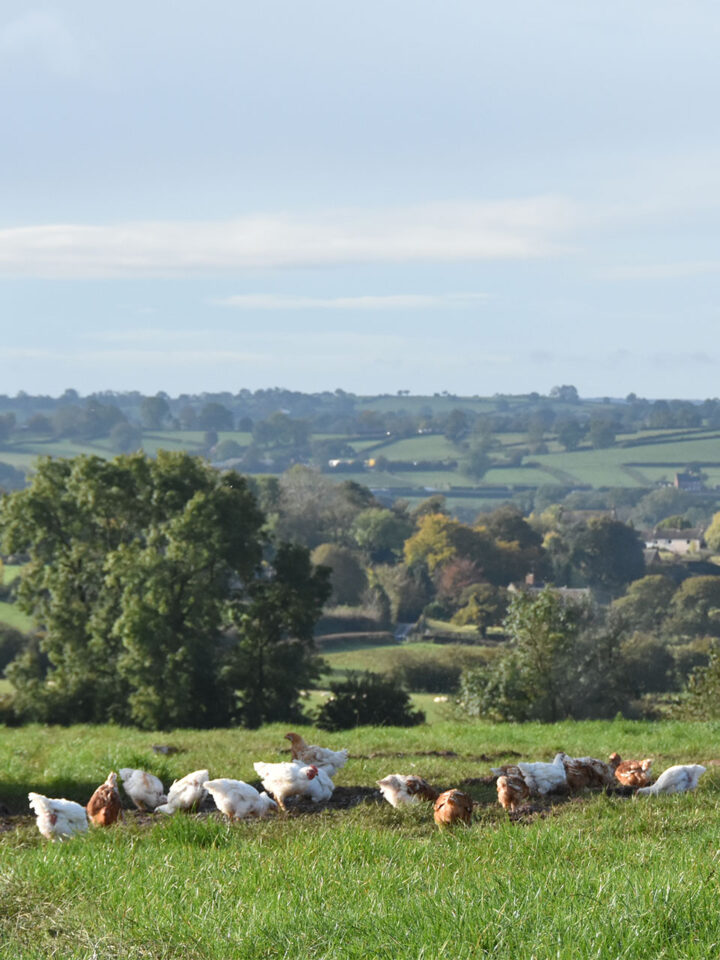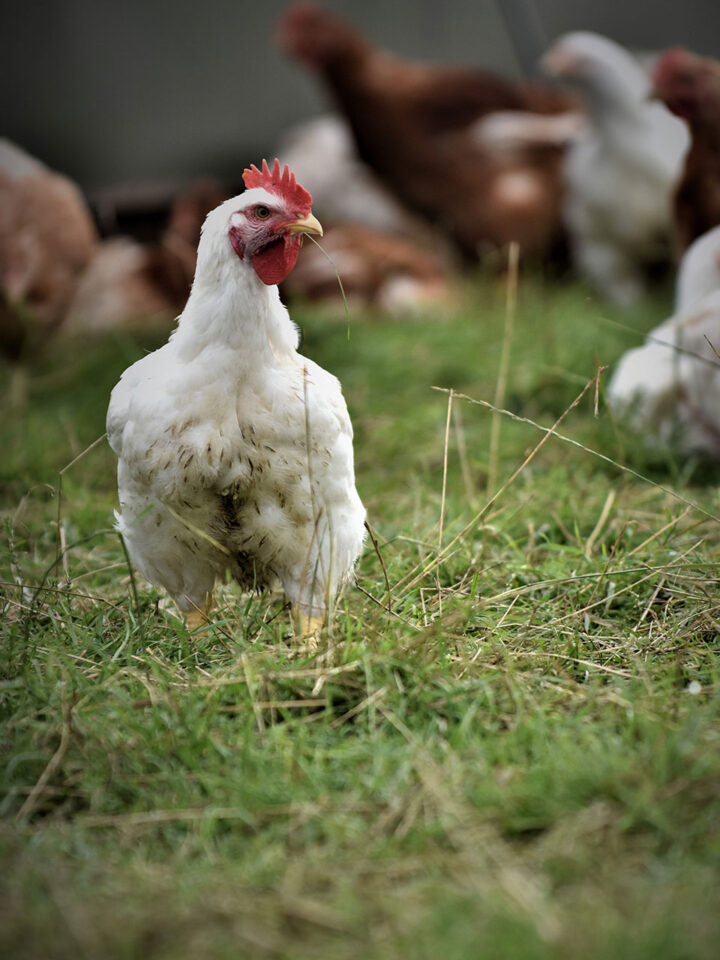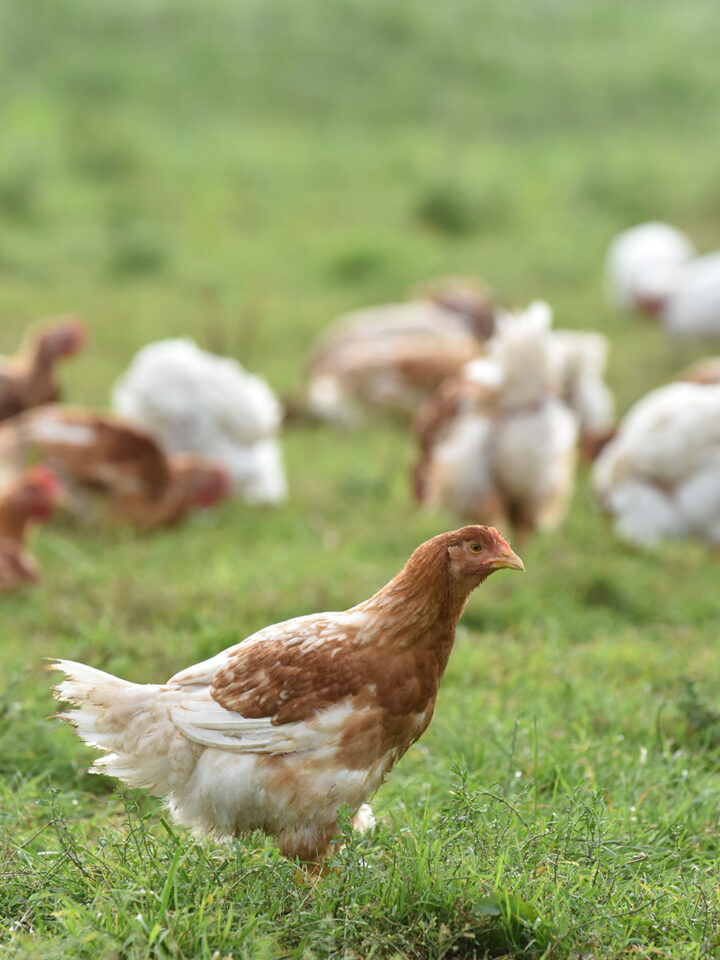From the roots of traditional farming to why chicken has become a staple on so many tables, here we speak with our farm’s Marketing Director, Matt Gorman, to delve into the journey of organic chicken at Daylesford. Discover what makes our chicken different, and what you can expect when you enjoy it in our pubs.
During the 1950s, poultry accounted for merely 1% of Britain’s total meat consumption. Table birds were primarily a by-product of the country’s rapidly expanding egg-laying industry, and most chickens destined for the table were surplus cockerels – the unwanted males from egg production.
Birds lived dramatically different lives from today’s commercial poultry. They enjoyed free-range conditions on much smaller farms in flock sizes of 200 to 400, foraging naturally and feeding on farm scraps supplemented by home-grown grains.
Sold through the farms’ local butcher’s shops or small, independent egg retailers, a chicken for the table was an expensive, occasional luxury that cost as much as £1 (around £17 in today’s money), which was a substantial sum for most British families when the average wage for a manual worker was £10 a week.
As a child in the 1960s, I watched my mother carefully select our chicken at the local butcher’s where birds were sourced directly from nearby farms. This prized bird would be roasted to perfection for Sunday’s family lunch, a sacred ritual around our dining table, where we savoured every bite together. But the chicken’s journey didn’t end there. My mother’s frugal wisdom ensured nothing went to waste. Every strand of succulent white meat would be carefully stripped from the bones, then transformed into hearty sandwiches or used to fill a comforting pie for a midweek dinner. Even the bones and skin would be given new life, simmered in a large pot to create a rich stock that would become the foundation for soups and gravies.
Today, not only is chicken cheap to buy, chicken consumption has also overtaken all other forms of meat consumption. In the UK, it is estimated that 3.2 million chickens are consumed every day. Of those, only 5% are free-range and 1% are organic. But cheap chicken comes with high welfare and environmental costs, and some would argue that flavour has been compromised.
The expansion of the table bird industry started in the USA in the late 1940s and 50s, spreading to Europe in the 1960s. The industry realised that chickens converted feed to meat more efficiently and quickly than cattle or pigs so they could be sent to market much sooner. But the industry pushed this capacity even further. Today’s genetically altered, intensively reared table bird is a breed that has been developed to gain weight in the shortest time possible. Reared indoors, in sheds housing over 30,000 birds, fed as much grain as they care to consume, kept healthy with a constant feed of routine antibiotics in their water supply, these birds can reach a marketable weight of 2kg in as little as 34 days – half the time it would have taken their 1950s’ relatives.
But breeders needed help in convincing consumers to accept chicken as a protein-rich, flavoursome, cheap alternative to beef and pork, and so they looked toward the large, emerging retailers – the modern supermarket.
One such large supermarket was successful in persuading their customers that intensively farmed chicken was a viable, healthy and flavoursome alternative to meat. Their 1958 ‘Chicken is Cheap’ campaign facilitated a dramatic increase in demand, driving sales into the millions. With the invention of convenience foods and ready meals, chicken sales increased significantly during the 1970s and have continued to increase significantly every year since.



At Daylesford, sustainable agriculture and animal welfare aren’t just a priority, they are the foundation of everything we do. Our chickens are organic from day one and we control every step of their journey, from birth to table. To our knowledge, Daylesford is the only farm operating this way, ensuring our breeding stock and chicks experience the highest welfare standards from their very first breath.
A Daylesford day-old chick begins life in our spacious sheds, sharing the space with 4,999 others (compare this to intensive farms where birds are crammed into sheds housing 34,000 birds). For four weeks, they have room to run, explore and express their natural curiosity while growing and developing their feathers.
By day 28, weighing approximately 900g, their free-range adventure begins. Meanwhile, intensive birds of the same age tip the scales at 1.6kg and face slaughter in just six days, having never stepped outside.
Daylesford’s birds roam expansive organic grasslands all day every day and are never confined or locked up. This freedom doesn’t just improve their quality of life; it creates superior taste and texture in the meat itself.
The birds enjoy a 100% organic, GM-free diet supplemented by nature’s bounty. Without genetically modified organisms, antibiotics, or artificial growth promoters, they develop naturally at their own pace, resulting in healthy, active birds with exceptional meat.
At around 70 days, our birds complete their journey at our own, purpose-built organic abattoir. Here, the same care and respect continues. While factory abattoirs process 10,000 chickens per hour across multiple production lines, each Daylesford chicken receives individual attention. Processing our entire flock of 5,000 takes most of a working day, and we wouldn’t have it any other way. Running our own abattoir ensures the animals experience the highest welfare standards available in British agriculture, right to the very end.
There is a third option when it comes to buying chicken in the UK – free-range. However, even free-range may not be what you think. This method raises serious questions and represents perhaps one of the biggest misconceptions facing UK consumers today.
Visit Daylesford’s blog to learn what ‘free-range’ really means and make a truly informed choice. Is there a difference between free range & organic chicken?
If you want to feel sure that your chicken has been raised abiding by the very best high welfare conditions and has enjoyed a good life, then chose a certified organic bird. And if you want to know that it’s come from a farm which owns the whole story of its birds, from birth to plate, then choose a Daylesford Organic chicken. Daylesford represents sustainable poultry farming at its finest: prioritising animal wellbeing and environmental stewardship to produce birds of exceptional quality and flavour. My mother would expect nothing less.
References:
Mrs Gorman
What can the history of meat production teach us about the future of protein? – Bryant Research
Poultry production through the ages – Farmers Weekly
The chicken, the factory farm and the supermarket
In charts: how chicken went from luxury to staple
The Poultry Site | Home
NFU poultry – NFUonline
Poultry and poultry meat statistics – GOV.UK